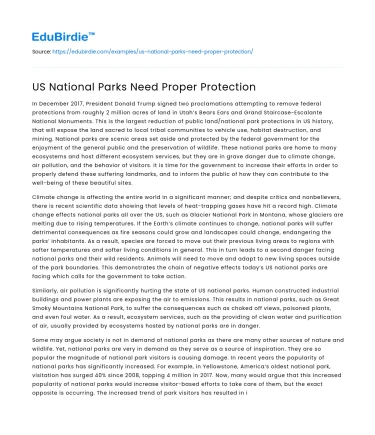In December 2017, President Donald Trump signed two proclamations attempting to remove federal protections from roughly 2 million acres of land in Utah’s Bears Ears and Grand Staircase-Escalante National Monuments. This is the largest reduction of public land/national park protections in US history, that will expose the land sacred to local tribal communities to vehicle use, habitat destruction, and mining. National parks are scenic areas set aside and protected by the federal government for the enjoyment of the general public and the preservation of wildlife. These national parks are home to many ecosystems and host different ecosystem services, but they are in grave danger due to climate change, air pollution, and the behavior of visitors. It is time for the government to increase their efforts in order to properly defend these suffering landmarks, and to inform the public of how they can contribute to the well-being of these beautiful sites.
Climate change is affecting the entire world in a significant manner; and despite critics and nonbelievers, there is recent scientific data showing that levels of heat-trapping gases have hit a record high. Climate change effects national parks all over the US, such as Glacier National Park in Montana, whose glaciers are melting due to rising temperatures. If the Earth’s climate continues to change, national parks will suffer detrimental consequences as fire seasons could grow and landscapes could change, endangering the parks’ inhabitants. As a result, species are forced to move out their previous living areas to regions with softer temperatures and softer living conditions in general. This in turn leads to a second danger facing national parks and their wild residents. Animals will need to move and adapt to new living spaces outside of the park boundaries. This demonstrates the chain of negative effects today’s US national parks are facing which calls for the government to take action.
Save your time!
We can take care of your essay
- Proper editing and formatting
- Free revision, title page, and bibliography
- Flexible prices and money-back guarantee
Similarly, air pollution is significantly hurting the state of US national parks. Human constructed industrial buildings and power plants are exposing the air to emissions. This results in national parks, such as Great Smoky Mountains National Park, to suffer the consequences such as choked off views, poisoned plants, and even foul water. As a result, ecosystem services, such as the providing of clean water and purification of air, usually provided by ecosystems hosted by national parks are in danger.
Some may argue society is not in demand of national parks as there are many other sources of nature and wildlife. Yet, national parks are very in demand as they serve as a source of inspiration. They are so popular the magnitude of national park visitors is causing damage. In recent years the popularity of national parks has significantly increased. For example, in Yellowstone, America’s oldest national park, visitation has surged 40% since 2008, topping 4 million in 2017. Now, many would argue that this increased popularity of national parks would increase visitor-based efforts to take care of them, but the exact opposite is occurring. The increased trend of park visitors has resulted in increased garbage and even human excrement. Obviously, this does not contribute positively to the welfare of national parks. And some may argue that national parks have staff to deal with these situations, but individuals willing to do this job are difficult to come by.
US national parks are suffering due to reasons such as climate change, air pollution, and a significant increase in park visitors. These are all worrisome facts but not nearly as worrisome as the lack of effort by the government to address these conundrums. National parks are US treasures that provide more than just beautiful scenery, and for this reason it is time for the government to increase their effort to properly protect National Parks (i.e: developing effective legislation and incentivizing the allocation of resources/funds for the protection of national parks and related organizations such as the NPCA) and to inform the public on their direct impact on the well-being of these landmarks.






 Stuck on your essay?
Stuck on your essay?

